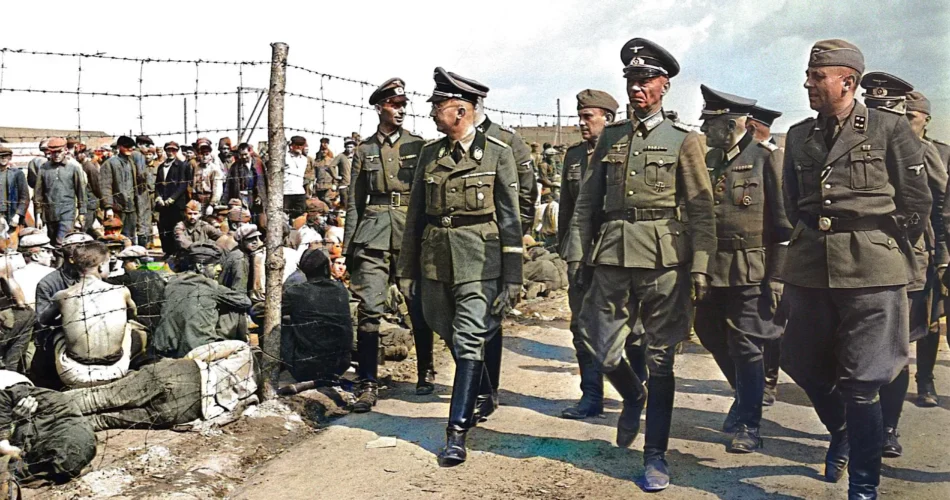In 1941, national socialism went east. They expected the war with the Soviet Union to be over within weeks and expected many more Red Army prisoners of war than they actually took. But, with what sounds almost like inhumane foresight, they did not prepare for the vast numbers—in any case, not in the way in which one would expect from a civilized society.
Fast Track:
Short story
TL;DR
Upon capture, the Germans shot Red Army commissars, their political enemies, in order to rid the world of the adherents to Bolshevism. Eighty percent of their marked units reported having done so during Barbarossa. Ill-treatment and the indiscriminate shooting of Russian POWs was not just the result of specific orders from above; neither was it necessarily conducted in a disciplined manner. Records in the division and others indicate that wild and often indiscriminate shootings of Soviet POWs began during the first days of the campaign.
The encirclement battles had resulted in the capture of thousands of Soviet prisoners, many of whom were already malnourished or the survivors of previous famines in the Soviet Union. Now, even though they had been encircled, German soldiers were encouraged by their higher-ups to execute Soviet soldiers found individually or in small group behind the lines as if they were partisans, and prisoners who were wounded or sick were also often shot on the spot.
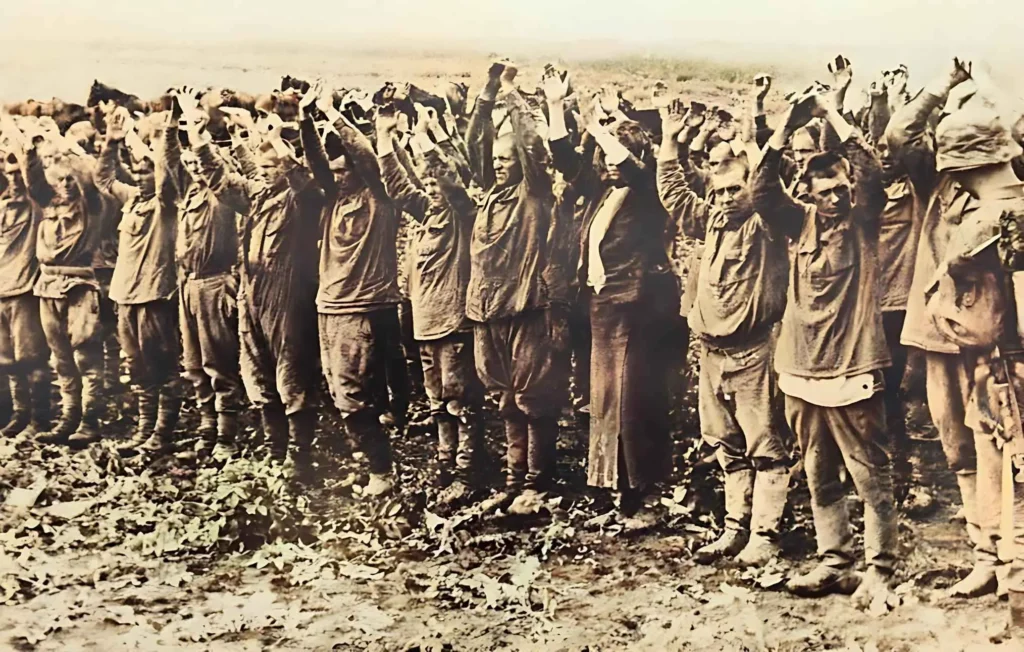
Many Germans had closed their hearts to such sites. “If I had known the rest of it, I think I would have run away.” Long columns of half-starved Soviet prisoners snaked across the countryside on their way to the prisoner of war camps, which were sometimes hundreds of kilometers away and took days or weeks to get to. The Germans, having been bombarded by newsreels referring to the Soviet prisoners as Mongols, Asiatics, and subhuman Bolsheviks, beat their captives. The wounded often perished first, followed by those who fell sick or were too tired to walk due to their malnourishment.
So many were shot around the vicinity of Vyasma later in the campaign that the commander of the rear area was uneasy about its impact on enemy propaganda. Columns devoured everything by the side of the road, including the leaves off the trees. Göring even boasted, “Hunger among Russian prisoners has reached such an extreme that it was no longer necessary to send them under armed guard to the rear. It is enough to put at the head of a column of prisoners a camp kitchen; thousands and thousands of prisoners trail along like a herd of famished animals.”
Rail transport was available, but the open freight cars were no luxury. There was no protection from the Russian winter, which froze 20 percent of them to death on average, but some journeys reportedly had a death rate of 70 percent. When the trains reached their destinations, hundreds or sometimes even thousands of frozen corpses would tumble from the open doors. But there was a fear from some units that the rail cars would be contaminated by the supposedly sub-human captives, and so the 16th Army instructed its formations not to transport prisoners using the trains.
Those unlucky enough to survive the journey found themselves at one of over 80 Soviet prisoner of war camps. There were three types of these camps: Dulags (transit camps), Stalags (base camps for enlisted men and NCOs), and the smaller Oflags (for officers). Often, especially in practice, all types of camps were no more than an open space fenced in by barbed wire. Generally speaking, the prisoners were not registered by name except twice in the Soviet prison of war camps and again later in the death camps of the Holocaust. Sometimes, there was no place to stay except for some mud huts that the prisoners carved for themselves, and many used to freeze to death when winter set in. Once winter appeared, the poorly equipped German soldiers often took their prisoners’ coats and boots. The toilets were practically not there, originating very rarely.
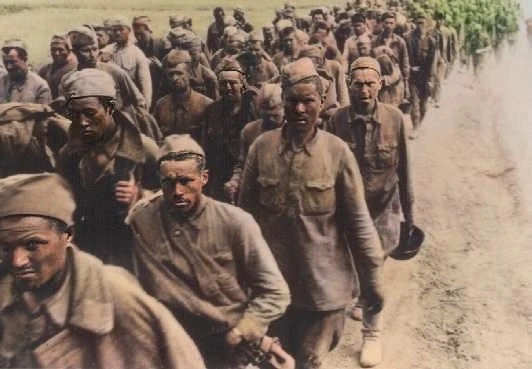
At one encampment near Orel, thousands of Soviet wounded lay on the open ground with no shelter and little medical care. “Nearly every day we had men die of exhaustion. The others would take their dead back to camp to bury them there. They would take turns carrying corpses and never seemed in the least moved by them. The camp graveyard was very large; the number of men under the ground must have been greater than that of those still among the living.”
By mid-July 1941 the OKW and RSHA agreed that a number of prisoners would be separated and then murdered by special SS units. From October 1941 Einsatzgruppen were allowed into the prisoner of war camps where they shot Jews, commissars, officers, and other political opponents. In many cases, they could not identify who was who, so many non-Jews, non-officers, and non-commissars were shot instead or in addition. Roughly a hundred thousand Jewish prisoners were separated and given this special treatment.
In September, German camp guards and guards were informed they would be punished if they used their weapons too little, and the food—well, there basically wasn’t any. Some reportedly had 100 grams of bread a day, and the Ministry of Food allocated 1,561 calories a day for prisoners, but the official calorie quotas were not met, and when they were, they were starvation rations anyway. The German high command urged its soldiers not to feel sorry for the starving prisoners and to remember that every ounce of food that is given to the prisoners is food that isn’t available and thus taken from the German people at home or German soldiers. For National Socialists, food was seen as a zero-sum economic game.
Prisoners ate grass, leaves, bark, pine needles, nettles, sometimes a stray dog, horse meat if the guards were generous. Desperate prisoners would dig into the ground so much that they found roots and worms to eat. Prisoners would struggle to lick their plates, while the German guards would laugh at the poor savages. Germans made an excuse for cannibalism taking root: because of the low level of civilization of the Soviet man.
Men killed one another for a piece of bread or a drop of water in the small region of Minsk, where more than 140,000 prisoners were starving. Just as the weather was beginning to turn, in late October 1941, Army Quartermaster General Wagner cut off supplies of rations to prisoners who could not work. Death rates in the camps shot up to 1 to 2.5 percent a day.
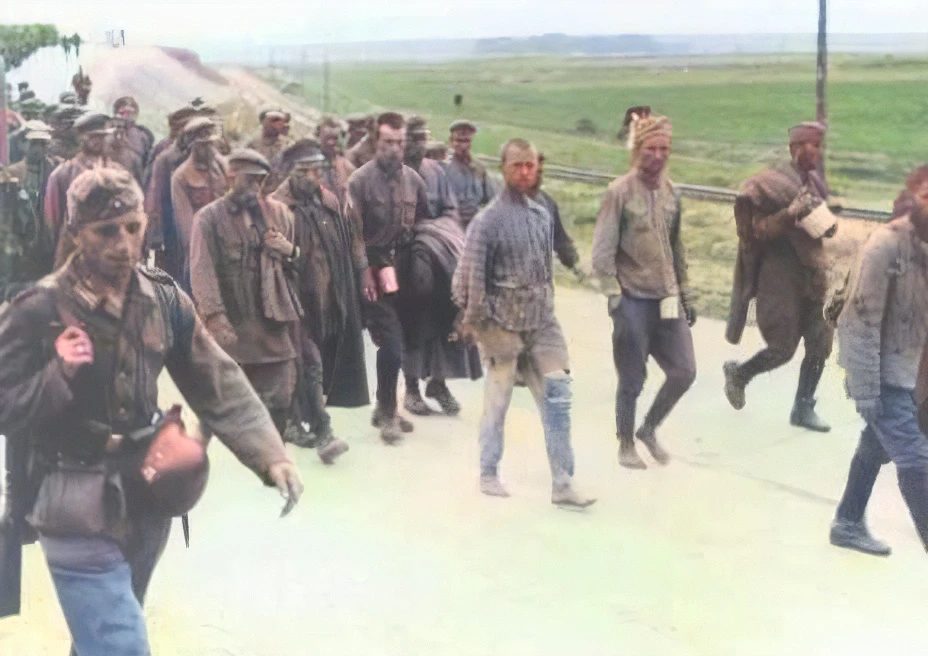
At Kirov 582 in November 1941, when a rear-security unit replaced the 9th Army, dogs seized 50 times the ration of one Soviet prisoner. Men were also packed into the one-story barracks of the camp, and two of the latrines were all that separated the barracks from one another. Unsurprisingly, both typhus and cannibalism erupted that fall at Dulag 185, Dulag 127, and Stalag 341 in Mahileu.
Witnesses saw mountains of unburied corpses outside the barbed wire. Some 30,000 to 40,000 prisoners died in these camps — at Dulag 342 at Molodechno. Conditions got so bad that prisoners submitted written petitions asking to be shot. At Stalag 306 at Karabakh, German guards reported that prisoners ate the bodies of comrades who had been shot, sometimes before the victims were dead.
This had been designed to accommodate 30,000; instead, it had 100,000 prisoners of war and another 40,000 civilians as well. All the prisoners were packed like sardines between the barbed wire and had to urinate and defecate where they stood; at every move, it was upon excrement and urine that their bare feet trod. Brute force had to be used by the guards to keep discipline. Some 109,500 people died there.
The rate of atrocity was not just recorded in German reports. The Polish resistance in occupied Poland recorded the death rates of Soviet prisoners of war in the camps in 1941-42. According to their reports, some 45, 690 people died in the camps in the General Government in a mere 10 days, between the 21st and 30th of October 1941. Local peasants in both types of locations, in Poland and in the Soviet Union, were ready to help feed the starving Soviet prisoners. Sometimes the Germans allowed it; other times they refused. In one such instance, the Germans shot the Polish women carrying the milk jugs and destroyed whole Polish villages.
About half a million Soviet prisoners of war starved to death in the General Government. Skilled workers had been taken from the ranks of inmates sent to the Eastern Front in 1941, severely curtailing the supply of labor in German armaments factories. They tried to compensate by employing women and old men, but this was inadequate. They had to turn to Soviet prisoners of war, but it was not until the 13th of October 1941 that Hitler changed the policy to allow this to happen. For many of them, it was too late. Most of their prisoners were either now dead or unable to work because of malnutrition or disease, with only 200,000 available to work right away.
It was not until the spring of 1942 that the situation began to improve, following an order from Hitler that Russian prisoners should receive sufficient rations. Over the war years, Soviet prisoners of war were to die in German camps at a rate of approximately 58%, though in the opening months of the war, it was probably much higher. Of German prisoners of war in Soviet hands, 13.5% died, and that includes the Sixth Army at Stalingrad who were starved in their pockets and who died a few weeks after capture from the traces of that malnourishment. By comparison, the death rate for British and American POWs in Germany was less than 5%, which is just indicative that this wasn’t something that happened by accident, which some people suspect, it was a policy.
But during the first six months, some 3.3 million went into German captivity; only about a million of them were still alive by the end of 1941 and half of them were too unfit to be carried off to the Reich as slave laborers. Overall, during the war, 5.7 million Soviet soldiers were captured by the German army in World War II. Almost 3 million Soviet prisoners were put to work for the Germans at home, where four hundred thousand would die.
Still, the racist attitude of the German soldiers caused extra suffering en route to Germany. Various commanders tried to march their prisoners on foot across the newly conquered territories in order not to infect the German railroad cars with the “sub-humans.” Little wonder, then, that German industry received scant help from slave labor before 1942, and that forced labor productivity never approached that of the German workers.
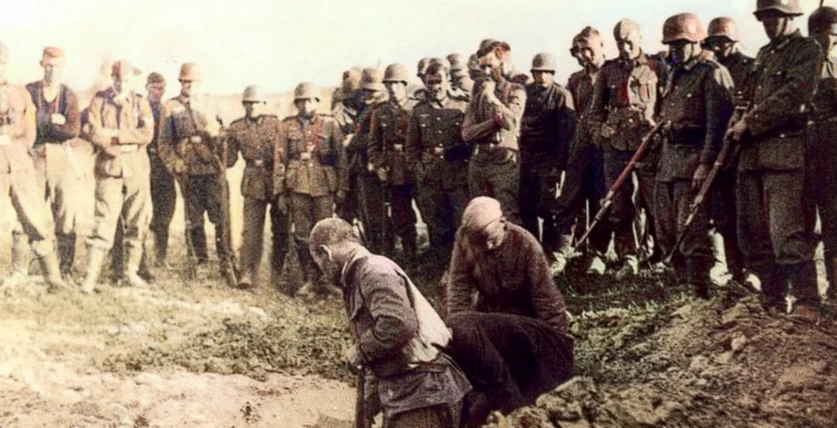
As many as 3.1 to 3.3 million Soviet prisoners of war died in German hands in World War II, irrespective of which organization had them in its custody at the time of their deaths. Those prisoners were the moral responsibility of the German army that had captured them, yet some people appear to believe that the Wehrmacht bore no responsibility at all for any crime committed in World War II, certainly not the murder of commissars, prisoners of war, or Jews. I mean, German generals like Guderian, von Manstein, and the beloved Franz Halder said they were innocent, and we must believe those honorable gentlemen. Plus, if you read the military history books written by German veterans like Karowski and Haapt, which, by the way, get great reviews at many internet book sites, you’ll hear all about the Soviet atrocities and nothing about the German ones. So, of course, why would we accuse the amazingly amazing Wehrmacht of committing such crimes?
It was only as late as the 1970s that historians really began to reflect upon the substantial nexus between the outbreak and course of war and the mass murder of “undesirable elements” and “inferior races.” It might also help to explain why many a veteran to this day tenaciously clings to the myth that the Wehrmacht was not party to the policy of annihilation at work in the East. Of course, it was to some extent true that German leaders pointed to the advantages of a more decent treatment of prisoners, but these were exceptions to the rule and then usually, too, for ulterior motives that served Germans more than the interests of the inmates.
While others, like General Lemeson, commander of the 47th Panzer Corps, complained that his men were shooting prisoners of war, deserters, and civilians. “This is murder. The German Wehrmacht is waging this war against Bolshevism, but not against the united Russian peoples. We want to bring back peace, calm, and order to this land, which had suffered terribly for many years from the oppression of a Jewish and criminal group. A Russian soldier who had been taken prisoner while wearing a uniform and after he puts up a brave fight has the right to decent treatment.” This instruction does not change anything regarding the Führer’s order on the ruthless action to be taken against partisans and Bolshevik commissars. So even here, in a best-case scenario where a German general was calling for the humane treatment of Soviet soldiers, it was still all right to kill commissars, who were soldiers in uniform, and partisans.
Although the commissars within the Red Army wore uniform, they were regarded not as combatants but as political functionaries. One cannot but emphasize that very often the commissars sent to the front were neither military men nor even Bolsheviks in the sense of Party membership. They were party activists chosen for their ideological commitment and political loyalty—definitely dangerous for the Wehrmacht troops fighting them in the Soviet Union. A commissar was not even subject to the Geneva Convention as a prisoner of war; he could be shot on the spot without any warning. The Army High Command’s fear that such hardliners might continue disseminating propaganda in the Reich if taken prisoner of war was a major factor dictating the shooting of political commissars of all kinds—a policy illegal by all international rules. And as we have mentioned earlier, 80 percent of all Wehrmacht units on the Eastern Front reported having executed commissars during Operation Barbarossa.
Of course, he wasn’t very innocent, was he? Neither was Generaloberst Franz Halder, the Chief of the General Staff since October 1940. Müller, General Officer of Special Duties attached to Halder, had been subject to Halder’s directives regarding military jurisdiction within the army and against the population of occupied territories. Since Halder was willing to let the troops participate in the intended ideological war, the Army High Command formulated its own draft that confined military jurisdiction during Operation Barbarossa to the maintenance of discipline and expected the troops to deal themselves with civilians impeding or inciting others to impede the Wehrmacht. In cases where such criminal elements could not be shot while fighting or escaping, an officer was to decide whether they were to be shot. The Army High Command also took the initiative against the commissars in the Red Army. As bearers of the Jewish-Bolshevik worldview, they were to be executed after being taken prisoner, on the orders of an officer who had to identify the commissar in consultation with two other officers or NCOs.
The Commissar Order was, however, drafted in its first form by High Command, and the Wehrmacht and Army High Commands were also responsible for prisoners of war. The army had to sort civilians and prisoners of war according to nationality and politics, and at the outset of the campaign, the Wehrmacht—not the Einsatz commandos or the SS—culled selections for prisoners of war in the POW camps, and it was only on 7 October 1941 that this was changed and the Army High Command allowed Einsatz commandos direct entry into the camps. Before this date, the Wehrmacht had the responsibility for the camps.
The Wehrmacht also impressed Soviet prisoners of war into their army, who may have made up about 40% of some support units by the end of 1941. The army chiefs were not just following Hitler’s dogmatic beliefs; they were not just victims of their own professional heritage. They, too, felt the perils of Russia and Bolshevism must be removed once and for all. Hitler was the Supreme Commander of Wehrmacht. If he’s guilty, quickly, so is the Wehrmacht, obeying his orders and making their own. Not only that, he set the moral and ideological framework for what the army did.
But even before the wars got underway, Hitler was explaining to the generals that the coming war was a war of annihilation. So this isn’t like they didn’t know. In fact, they were keen on it, as it were. Field Marshal von Brauchitsch—the commander-in-chief of the army—advised his commanders to consider the German-Soviet war as a clash of two ideologies and called for his troops to behave with every bit of severity. General von Kuchler, commander of the 18th Army, sided with Hitler and said that National Socialist Germany and Marxist Socialist Soviet Union were doctrinally and racially different, and he complied with the Commissar Order.
“The war against Russia is an important chapter in the struggle for existence of the German nation. It is the old battle of the Germanic against the Slav peoples, of the defence of European culture against Moscovite Asiatic inundation, and the repulse of Jewish Bolshevism. This war must lead to the destruction of present-day Russia, and therefore it will have to be waged with unparalleled severity. Every military action must be guided in planning and execution by an iron will to exterminate the enemy mercilessly and totally. In particular, no adherents of the present Russian Bolshevik system are to be spared.”
There followed in 1941 the Barbarossa Directive of the 13th of May and the Commissar Order of the 6th of June, and added to them the Guidelines for the Conduct of the Tro troops in Russia, published on the 19th of May 1941 by the Wehrmacht. All of those orders stated expressly that this was essentially an ideological conflict—it was against Judeo-Bolshevism; that commissars, partisans, and Jews were to be eliminated, and that was known before the Wehrmacht agreed with the SS that those elements of the prisoner of war camps should be liquidated.
Now, it is interesting because some people claim that it was OK to inflict such suffering on the Soviet prisoners of war because they say that the Soviet Union did not sign or agree to the Geneva Convention. Well, firstly, even if the latter is some sort of moral argument for the inhumane treatment of human beings who themselves had no option in signing the treaty, on the 17th of July 1941, the fact is that the Soviets had declared that if the Germans did the same, they would adhere to the Geneva Convention. The German response, by Hitler himself, was to simply reject Soviet intentions. So, in response to the German response, the Soviets did not adhere to it. And even more than that, the OKW, the armed forces high command of the military, did state on the 16th of June 1941 that even if the Soviet Union hadn’t recognized the Geneva Convention, the Germans would adhere to it, with some exceptions. Well, that was an outright lie, and the point is this: even if the Soviet Union hadn’t signed the Geneva Convention, Germany had. And even if they hadn’t, that is no excuse in treating individual human beings like this. Why should individual human beings suffer just because governments always fail to do their jobs correctly?
Now, the fact is that this suffering was what the National Socialists intended for their ideological enemies, in this war of annihilation. Equally, a food crisis was under way for the Germans. The Wehrmacht, at the same time, had to be fed without reducing rations for German civilians. This was not genocide because the catastrophic conditions also existed in camps in the Reich. If mass deaths of Soviet prisoners of war were not the result of ignorance or incompetence, neither were they the result of a deliberate policy to exterminate – but, on the other side, that does not mean that the Third Reich’s leaders are exonerated. To the Nazi leadership, it was axiomatic that Germans and Russians could not both be fed. The former would then be supplied at the expense of the latter, no matter what the costs were.
With logistics all over the place on the 16th of September 1941, Göring decided to improvise. He ordered the German soldiers in the East to simply live off the land. Food from the Soviet Union was to be allocated first to German soldiers, then to Germans in Germany, then to Soviet citizens, and then to Soviet prisoners of war. German commanders would have to continue the war, which meant feeding soldiers, which meant starving others. This was the political logic and the moral trap for the soldiers and the low-level officers. There was no escape but insubordination or surrender to the enemy, prospects as unthinkable for German troops in 1941 as they had been for Ukrainian communists in 1932.
Yes, Hitler obviously was responsible for the ideological part of the war of annihilation and for implementations of things like the Commissar Order. But on those points, he had supporters, helpers, and believers of the same kind within the Wehrmacht High Command. The orders were agreed on, supported, and co-drafted by them, and from the very beginning they took charge of the Soviet prisoners. It can’t claim that it didn’t know how many prisoners there would be because they expected the war to be over in a few weeks, and thus a large intake. And they could not claim that it was an accident since the outlines of the plans had been written before the beginning.
And all of them were not committed by Hitler alone. The responsibility of genocide belongs to the Wehrmacht, its generals, and many of its soldiers as much as it does on Hitler. So, I will leave you with a last thought: the Third Reich concentration camps also took in Soviet prisoners of war, and their character started to shift with this inclusion. The SS turned Dachau, Buchenwald, Sachsenhausen, Mauthausen, and Auschwitz from the constellation of the concentration camps into killing facilities as the SS used them to kill Soviet prisoners of war. Some eight thousand Soviet prisoners were killed at Auschwitz, ten thousand at Mauthausen, and eighteen thousand at Sachsenhausen. At Auschwitz, on the 3rd of September 1941, a pesticide called Zyklon B was tested on Soviet prisoners. For this reason, some have said that the treatment of Soviet prisoners of war in the fall of 1941 became an important watershed for the Third Reich in the process of mass murder and the Holocaust.
Short story
During World War II, the treatment of Soviet prisoners of war (POWs) by Nazi Germany was both brutal and dehumanizing, deeply influenced by Nazi ideology which viewed the Slavic peoples as subhuman. The grim fate of these POWs is a stark reminder of the horrifying impact of war when combined with racial hatred.
Treatment and Conditions of Soviet POWs
Upon capture, Soviet POWs were subjected to immediate harsh treatment. Many were executed on the spot, especially political officers and those seen as ideologically dangerous. Those who survived faced forced marches to POW camps across occupied territories under dire conditions without adequate food, water, or medical care, leading to extremely high mortality rates.
Conditions in the POW Camps
The camps were often mere enclosures with barbed wire, lacking basic shelter or sanitation. Overcrowding, starvation, and exposure to harsh weather were common, causing countless deaths. The Nazi regime’s portrayal of these prisoners as subhuman justified their maltreatment in the eyes of German soldiers and facilitated widespread abuses.
Forced Labor and Executions
Survivors were often sent to forced labor, contributing to the Nazi war effort under brutal conditions. Special SS units conducted systematic executions within the camps, targeting Jews and those identified as significant political figures.
Key Points with Icons:
- 📜 Ideological Brutality: Immediate execution of commissars and harsh treatment of captives.
- ❄️ Marches and Camp Conditions: Forced marches to inadequate camps, high death rates due to exposure and starvation.
- 🔗 Forced Labor and Systematic Executions: Utilization of survivors for labor and targeted killings by SS units.
The treatment of Soviet POWs during World War II underlines the lethal combination of ideological warfare and racial prejudices, illustrating a dark chapter in the history of human conflict.
